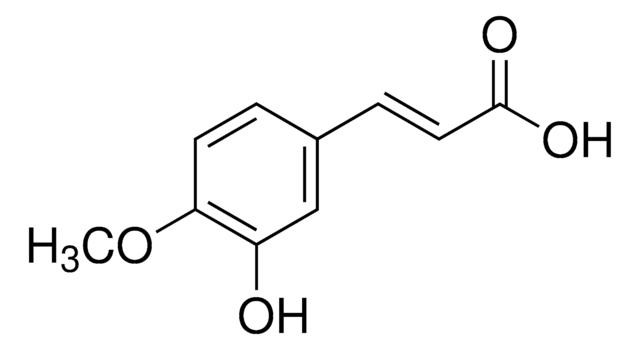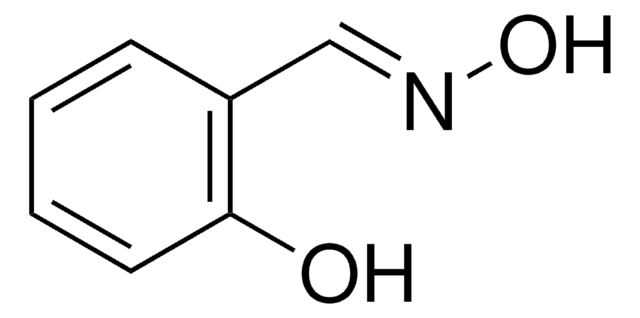103012
3-Hydroxy-4-methoxycinnamic acid, predominantly trans
97%
Se connecterpour consulter vos tarifs contractuels et ceux de votre entreprise/organisme
About This Item
Formule linéaire :
HOC6H3(OCH3)CH=CHCO2H
Numéro CAS:
Poids moléculaire :
194.18
Numéro CE :
Numéro MDL:
Code UNSPSC :
12352100
ID de substance PubChem :
Nomenclature NACRES :
NA.22
Produits recommandés
Pureté
97%
Forme
solid
Pf
230 °C (dec.) (lit.)
Groupe fonctionnel
carboxylic acid
Chaîne SMILES
COc1ccc(\C=C\C(O)=O)cc1O
InChI
1S/C10H10O4/c1-14-9-4-2-7(6-8(9)11)3-5-10(12)13/h2-6,11H,1H3,(H,12,13)/b5-3+
Clé InChI
QURCVMIEKCOAJU-HWKANZROSA-N
Catégories apparentées
Description générale
3-Hydroxy-4-methoxycinnamic acid, predominantly trans is available as white crystals. 3-Hydroxy-4-methoxycinnamic acid is isolated from the aerial part of Artemisia capillaris, Chinese medicinal plant. It is a component of chinese herbal medicine used for a pain killer and stomachic. It is an efficient acetylcholine inhibitor. 3-Hydroxy-4-methoxycinnamic acid is bioactive metabolite of Spilanthes acmella Murr. It increases the resistance of low-density lipoprotein (LDL) to oxidation.
Application
3-Hydroxy-4-methoxycinnamic acid was used in the synthesis of tranilast and various tranilast analogs (cinnamoyl anthranilates) by genetically engineered Saccharomyces cerevisiae yeast strain. It was also used in the synthesis of glycoside compounds by undergoing glycosidation.
Code de la classe de stockage
11 - Combustible Solids
Classe de danger pour l'eau (WGK)
WGK 2
Équipement de protection individuelle
dust mask type N95 (US), Eyeshields, Gloves
Faites votre choix parmi les versions les plus récentes :
Déjà en possession de ce produit ?
Retrouvez la documentation relative aux produits que vous avez récemment achetés dans la Bibliothèque de documents.
Les clients ont également consulté
Supaluk Prachayasittikul et al.
Molecules (Basel, Switzerland), 14(2), 850-867 (2009-03-04)
Spilanthes acmella Murr. (Compositae) has been used as a traditional medicine for toothache, rheumatism and fever. Its extracts had been shown to exhibit vasorelaxant and antioxidant activities. Herein, its antimicrobial, antioxidant and cytotoxic activities were evaluated. Agar dilution method assays
T S Wu et al.
Bioorganic & medicinal chemistry, 9(1), 77-83 (2001-02-24)
Five new constituents including a flavonoid, artemisidin A (1), and four coumarins, artemicapins A (2), B (3), C (4) and D (5), together with 70 known compounds (6-75), have been isolated and characterized from the aerial part of Artemisia capillaris.
Mathieu Renouf et al.
The Journal of nutrition, 140(2), 259-263 (2009-12-17)
Chlorogenic acids (CGA) are antioxidants found in coffee. They are becoming of interest for their health-promoting effects, but bioavailability in humans is not well understood. We hypothesized that adding whole milk or sugar and nondairy creamer to instant coffee might
I-Min Liu et al.
The Journal of pharmacology and experimental therapeutics, 307(3), 1196-1204 (2003-09-17)
We investigated the mechanism(s) by which isoferulic acid lowers plasma glucose levels in streptozotocin-induced diabetic rats (STZ-diabetic rats). In STZ-diabetic rats, isoferulic acid dose dependently lowered plasma glucose concentrations and increased plasma beta-endorphin-like immunoreactivity (BER). Both of these effects of
I M Liu et al.
British journal of pharmacology, 129(4), 631-636 (2000-02-22)
Wistar rats with streptozotocin-induced diabetes (STZ-diabetic rats), which is similar to human insulin-dependent diabetic mellitus (IDDM), were employed to investigate the antihyperglycemic action of isoferulic acid. A single intravenous injection of isoferulic acid decreased the plasma glucose in a dose-dependent
Notre équipe de scientifiques dispose d'une expérience dans tous les secteurs de la recherche, notamment en sciences de la vie, science des matériaux, synthèse chimique, chromatographie, analyse et dans de nombreux autres domaines..
Contacter notre Service technique








